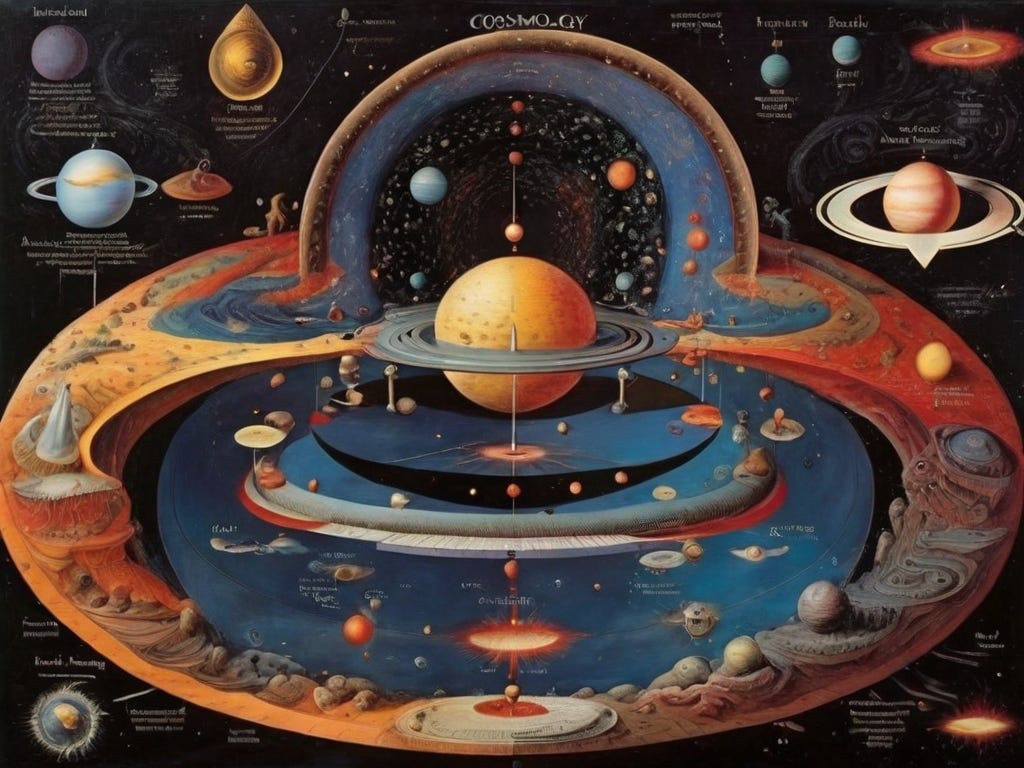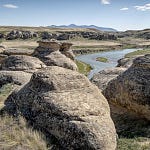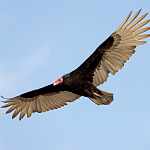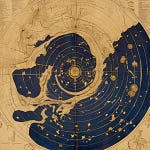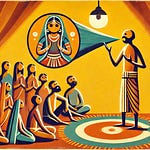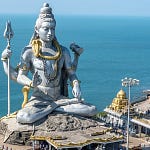Let’s open with a poem.
Now is the Time
Now is the time to remember
that our green globe is the best-dressed in the ball
lit through with organic filaments
bombastic living miracles.
Now is the time to turn off the engine and
set down exhaustion
into lakes that remain
and bask for
an
infinite
instant.
Now is the time
to be
a miracle
too.
Cosmology: It’s a Heck of a Word
It is! It’s up there with ontology and epistemology, the kind of word that opens us up to broad ways of thinking. It’s an account or theory of the origin of the universe. Along with that view of its origin, cosmology implies principles and beings who govern our universe.
In story terms, we can say that the cosmology of a story is the largest conceptual framework, in which are nested the smaller frameworks. It's the largest explanation, the largest context, like the shell of the story egg. Or perhaps a better analogy is that cosmology is the bedrock which influences the chemistry of all the layers of soil, up to and including the topsoil. You see, cosmology speaks of the background of the story, but it also infuses each part of the story. It gives the big why’s and who’s and how’s of the story world, in which all smaller stories must take place.
We live in stories.
In popular scientific cosmology, we have the Big Bang and the theory of evolution. For those who live in that view, their daily lives are nested within that bigger picture.
Most other cosmologies are more personal, in the sense that there are beings who were and are involved in creation. That could be gods, the spirits of planets, animals, creators who create with clay, and more. There is a great variety. For those who are within those cosmologies, their daily lives are nested within this larger context.
Cosmology in Hinduism
Hindusim is varied to say the least, but there are trends. The branch of Hinduism that I studied and practiced was Bhakti-yoga, or Gaudiya Vaisnavism. It holds a personal cosmology, with all creation originating from a divine being, or rather, two divine beings, masculine and feminine. After the initial creation, those divine beings had a hand in subsequent sub-creations.
The big creation is where Divinity arranged the soup of matter into planets and stars. In the sub-creations, planets are populated with beings, and in further sub-creations, there are more beings, all within a universal governance with strata of gods, all the way to the top.
There are variations of this cosmology, within India and the larger area around her. It is as though the conceptual egg is multidimensional, existing in various ways for different people, yet with a common essential form. I’m afraid that’s the best metaphor I can think of now. I’m open to suggestions!
What are the variants? Some speak of Vishnu as the supreme originating deity. Others speak of Shiva, or Shakti. Some forego personal origins and say that the universe came from a void, or from an all-pervasive energy. Early Buddhism entered the scene with a teaching of interdependent causality, which you might roughly say means, everything causes everything (though there are greater concentrations of causality).
Jostling Cosmologies
If each of these cosmologies were a person, they’d often be bickering, and in fact the world is full of jostling cosmologies. If you hear two people making different claims about whether life came from matter or spirit, whether there was a big bang, whether creatures evolved from the ocean or were created in some other way, or perhaps both—you’re witnessing jostling cosmologies.
However, within a given story, we tend to find a single cosmology, a single world-view about the origin of things. From there comes the ontology of that world: what the story allows to be true. (Thanks to Sarah Kerr for that framing). In a given story, the cosmology may be spelled out or implied. It may be assumed to be the same as dominant modern world-views. In any case, there’s always a cosmology.
Let's use Lord of the Rings for an example, because the cosmology is spelled out clearly, at least if you get into the Silmarillion. Here it is: in the beginning there was one singer; from that singer came many singers. With their combined voices they created celestial harmonies. Then, one of those singers began to sing in disharmony; kicking off the troubles of creation, much as Lucifer did when he rebelled against the Judeo-Christian god. From there come Elves, Men, Dwarves, Hobbits. And in a particular place called the Shire, in Bag End, there’s Bilbo!
Cosmology is the biggest layer. Within that we have nested layers, and within all of that we have the actions of our characters, or, in our lives, ourselves.
Worlds Within Worlds
Within the cosmology of a story, nested inside, lie other layers of explanation. We've been talking about big picture cosmology—the origin of the universe and such—but thought of any scale has its own cosmology. It’s in pop culture. Every Spiderman comic doesn’t go into the bigger picture in the Marvel universe, but it’s there. Spiderman might be fighting a street thug, but Galactus is out there, him and other godlike beings who are part of the story’s backdrop.
Let's look at the Christian cosmology. In the beginning, there was God, who created the worlds, waters, and the rest of the support for life. He then created humankind and put them in the Garden of Eden. Aye, there’s the rub. They disobeyed him, got kicked out of the garden, and we’ve had trouble ever since.
Here’s one version of scientific cosmology. There was nothing, then there was a big bang, which created a universe with lots of empty space, and some plasma: superheated matter. This plasma coalesced into stars, which brought light to the universe, which had been dark until then. When these stars grow old they implode then explode, spreading complex matter throughout the universe. This becomes planets, asteroids, you, me; within at least one of these planets, ours, this matter gave rise to the first stage of life; it’s become more complex over time.
Cosmology and Colonisation
Cosmologies are often used to justify conquest. For example, the theory of evolution was used to place Europeans at the top of an evolutionary hierarchy, a ladder from simple celled organisms to animals, then to ‘primitive people,’ and finally to ‘civilized people.’ The cosmology of modern capitalism borrows from the theory of evolution, emphasizing survival of the fittest over cooperation for the good of all.
Religious world-views have also been used to justify conquest, usually with a justification that goes something like, ‘We are God’s chosen people.’
It should be said that categories like ‘religious’ and ‘scientific’ are so broad that they are useful only to an extent. Within scientific or religious groups, there are a many variations. These groups are patterns that make many people into large units, but there are overlaps between those units, and within each are individual people with diverse world-views.
Contrasting Cosmologies
When comparing cosmologies, one big distinction that comes up is animate vs. inanimate. The modern scientific cosmology is unusual in that it leans towards inanimate explanations. This could be because Western scientific cosmology has rebellion in its roots, against the Christianity it sprang from. This religion ascribes creation to a personal god, and has been repressive of scientific insights. From an animistic point of view, we might see the Western scientific worldview as a child who is rebelling against their repressive parent.
Zoom out from the conflicts in the world today and we see that they’re conflicts between world-views. Sometimes these world-views incite actions, and sometimes, when people want to carry out a certain action, they’ll look for a world-view to support it. Like, ‘I want that guy’s land. Hmmm… God made my people and chose them as the best.’
Sometimes world-view causes desire, and sometimes desire causes world-view.
Looking within yourself, you may find multiple coexisting cosmologies. You may be informed by certain aspects of science, but also informed by a more animistic view, seeing trees, animals, stars and planets as living beings. You might draw from the scientific cosmology when it comes to explaining bodily anatomy, but take a mystical view to explore matters of spirit. If you find yourself speaking with someone holding a different cosmology than your own, you might seek common elements between them. You might find that you share some influences.
We Live Apart
People seldom question their own cosmology, not to its fundaments.
Within the world of Middle Earth, this origin story is not considered a belief held by some people, but the way it actually happened. It may be that certain others have other views, but they’d be wrong. Could we have a story with jostling cosmologies, each of which have reality within the story world, even though they contradict each other? Good question, my friend.
Have you seen the film Killers of the Flower Moon? In it, different world-views rub shoulders. For the Osage people, a native group living in Oklahoma, a vision of an owl forbodes one’s death.Two Osage characters in the film, nearing death, see an owl enter their room. Non-Osage characters don’t see the owl. Now, we could say that the Osage are imagining the owl, but here’s a more interesting view. Their world-view is true, not imagination, but not everyone experiences the world that way. People experience the world according to their outlook, which stems from their cosmology.
Let’s try to include all that in one world-view, shall we? Suppose that world-views are like stain-glass windows between each of us and reality, and we see the world through that shaped, coloured glass. Or perhaps we are multidimensional beings in a multidimensional reality, where different truths can simultaneously be true.
How ‘Bout You?
Two people standing next to each other may be living in different cosmologies. within yourself, are there overlapping cosmologies? In those edge zones between them, is there turmoil, or a surprising generativity, like in a riparian ecosystems? I’m curious which cosmologies have been important in your life. Do they overlap, and if so, what grows in those ‘tween regions? Perhaps there are world views that you've left behind, and others that you're deepening into. I'd be interested to hear.
Closing with a Poem:
Sky high with boots on stone
and grass tufts with strong roots
Across crumbled peak-pieces
like clambering across elephants.
seeded here by wind opening seams in stone.
In the foothills of those great mountains
wondering if worlds are not apart
but layered together.
Ringed by a horizon of rising peaks
I find I have crossed a threshold.
I peer around the bend of a tunnel of air
and an ancient blue-skinned sage
turns and asks
how one so untrained as I
has come to be here.



